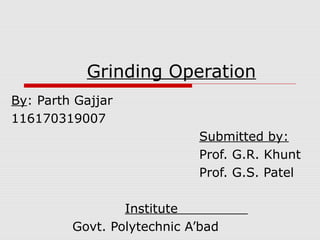Grinding operation
•Transferir como PPT, PDF•
44 gostaram•40,808 visualizações
...............
Denunciar
Compartilhar
Denunciar
Compartilhar

Recomendados
Recomendados
Mais conteúdo relacionado
Mais procurados
Mais procurados (20)
Milling machine-types-operations..etc..from L.NARAYANAN,M.E.,AP.MECH

Milling machine-types-operations..etc..from L.NARAYANAN,M.E.,AP.MECH
Semelhante a Grinding operation
Semelhante a Grinding operation (20)
Machine tool iii grinding superfinishing limit fit tolerance & surface f...

Machine tool iii grinding superfinishing limit fit tolerance & surface f...
Último
Último (20)
General Principles of Intellectual Property: Concepts of Intellectual Proper...

General Principles of Intellectual Property: Concepts of Intellectual Proper...
Micro-Scholarship, What it is, How can it help me.pdf

Micro-Scholarship, What it is, How can it help me.pdf
NO1 Top Black Magic Specialist In Lahore Black magic In Pakistan Kala Ilam Ex...

NO1 Top Black Magic Specialist In Lahore Black magic In Pakistan Kala Ilam Ex...
Salient Features of India constitution especially power and functions

Salient Features of India constitution especially power and functions
Plant propagation: Sexual and Asexual propapagation.pptx

Plant propagation: Sexual and Asexual propapagation.pptx
UGC NET Paper 1 Mathematical Reasoning & Aptitude.pdf

UGC NET Paper 1 Mathematical Reasoning & Aptitude.pdf
Basic Civil Engineering first year Notes- Chapter 4 Building.pptx

Basic Civil Engineering first year Notes- Chapter 4 Building.pptx
On National Teacher Day, meet the 2024-25 Kenan Fellows

On National Teacher Day, meet the 2024-25 Kenan Fellows
HMCS Max Bernays Pre-Deployment Brief (May 2024).pptx

HMCS Max Bernays Pre-Deployment Brief (May 2024).pptx
Python Notes for mca i year students osmania university.docx

Python Notes for mca i year students osmania university.docx
ICT Role in 21st Century Education & its Challenges.pptx

ICT Role in 21st Century Education & its Challenges.pptx
Interdisciplinary_Insights_Data_Collection_Methods.pptx

Interdisciplinary_Insights_Data_Collection_Methods.pptx
Grinding operation
- 1. Grinding Operation By: Parth Gajjar 116170319007 Submitted by: Prof. G.R. Khunt Prof. G.S. Patel Institute Govt. Polytechnic A’bad
- 2. INTRODUCTION TO GRINDING PROCESS • • • It is the only economical method of cutting hard material like hardened steel. It produces very smooth surface , suitable for bearing surface. Surface pressure is minimum in grinding. It is suitable for light work,which will spring away from the cutting tool in the other machining processes.
- 4. Types of grinding operation 1. Ruff or precision Grinding a) Snagging b) Off-hand 2. Precision Grinding a) Surface grinding b) Cylindrical grinding c) Center less grinding d) Form and profile grinding e) Plunge cut grinding
- 5. Grinding Process Grinding is an abrasive machining process that uses a grinding wheel as the cutting tool.
- 6. Surface Grinding Surface grinding uses a rotating abrasive wheel to remove material, creating a flat surface.
- 7. Cylindrical Grinding Cylindrical grinding (also called center-type grinding) is used to grind the cylindrical surfaces and shoulders of the workpiece. 1. External cylindrical grinding 2. Internal cylindrical grinding
- 9. Internal cylindrical grinding Internal grinding is used to grind the internal diameter of the workpiece. Tapered holes can be ground with the use of internal grinders that can swivel on the horizontal.
- 11. Form and profile grinding Form grinding is a specialized type of cylindrical grinding where the grinding wheel has the exact shape of the final product. The grinding wheel does not traverse the workpiece.
- 12. Plunge cut grinding Infeed (Plunge) Grinding is used to grind workpieces which have projections or shoulders, multiple diameters or other irregular shapes which preclude the use of through feed grinding. For example :- Grinding of crank shaft.
- 14. Electrochemical grinding The wheels and workpiece are electrically conductive. Wheels used last for many grindings - typically 90% of the metal is removed by electrolysis and 10% from the abrasive grinding wheel. Capable of producing smooth edges without the burrs caused by mechanical grinding. Does not produce appreciable heat that would distort workpiece. Decomposes the workpiece and deposits them into the electrolyte solution. The most common electrolytes are sodium chloride and sodium nitrate at concentrations of 2 lbs. per gallon